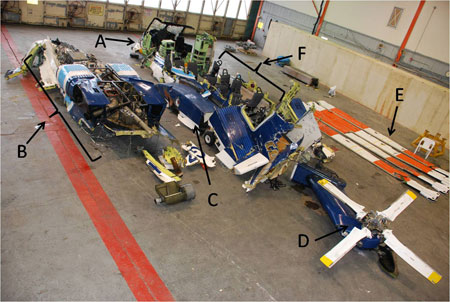The TSB estimated that (see report section 1.15.1):
CHI91 impacted with the water with an estimated force in the magnitude of 20g to 25g.
However because the structure absorbed some of that acceleration:
Except for the four passenger seats that bottomed out, the occupants were generally subjected to inertia load factors between at least 5.3g and 8.6gin the direction of the vertical seat axis. In addition, the helicopter struck the surface with a forward velocity of approximately 55 to 60 knots which would have introduced a horizontal force on the occupants of approximately 5g to 8g
The effect of these lower g levels are clearly evidenced by the suprisingly low level of impact injury amongst the passengers (though not the crew).
From the TSB report (1.3) it is clear both sponsons broke off (which is what Sikorsky's marketing said they would do):
Some floating debris was recovered by surface vessels including the left sponson and fuel bladder, rear cargo door, two life rafts, other lightweight buoyant materials, and some personal effects.
The right sponson and fuel bladder were not recovered.
On the rafts (from 1.12.7 - underling added):
The helicopter was equipped with two life rafts, one stowed in the forward portion of each sponson. Both life rafts were recovered fully inflated and floating near the impact site. The rafts likely inflated when the lanyards, attached to the rafts and used to manually inflate them, were pulled as the storage compartment's cover separated from the sponsons at the time of the impact.
The sole survivor in his testimony to the public inquiry did see the rafts blowing away in the wind (the raft sea anchors are manually deployed once someone is on board the raft - an area for possible design improvement).
The LH sponson was postioned alongside the fuselage:

It is clear that the sponson is not attached to the LH main landing gear support structure which is still attached to the fuselage.
Critically to this dicussion the LH liferaft bay remains at the front of the sponnson and attached to the fueslage.
Therefore I believe my earlier statment is correct Vertical Load based on facts.
I also note that in 1.12.7 it is clear that Jim L's point on the protection of ctitical systems was not properly addressed in the case of the S-92 to the satisfaction of the TSB:
The immersion switches in the wheel wells were disabled when the sponsons were torn away by the impact.
There is very little point being able to survive an impact if you drown rapidly because essential safety systems have been disabled.